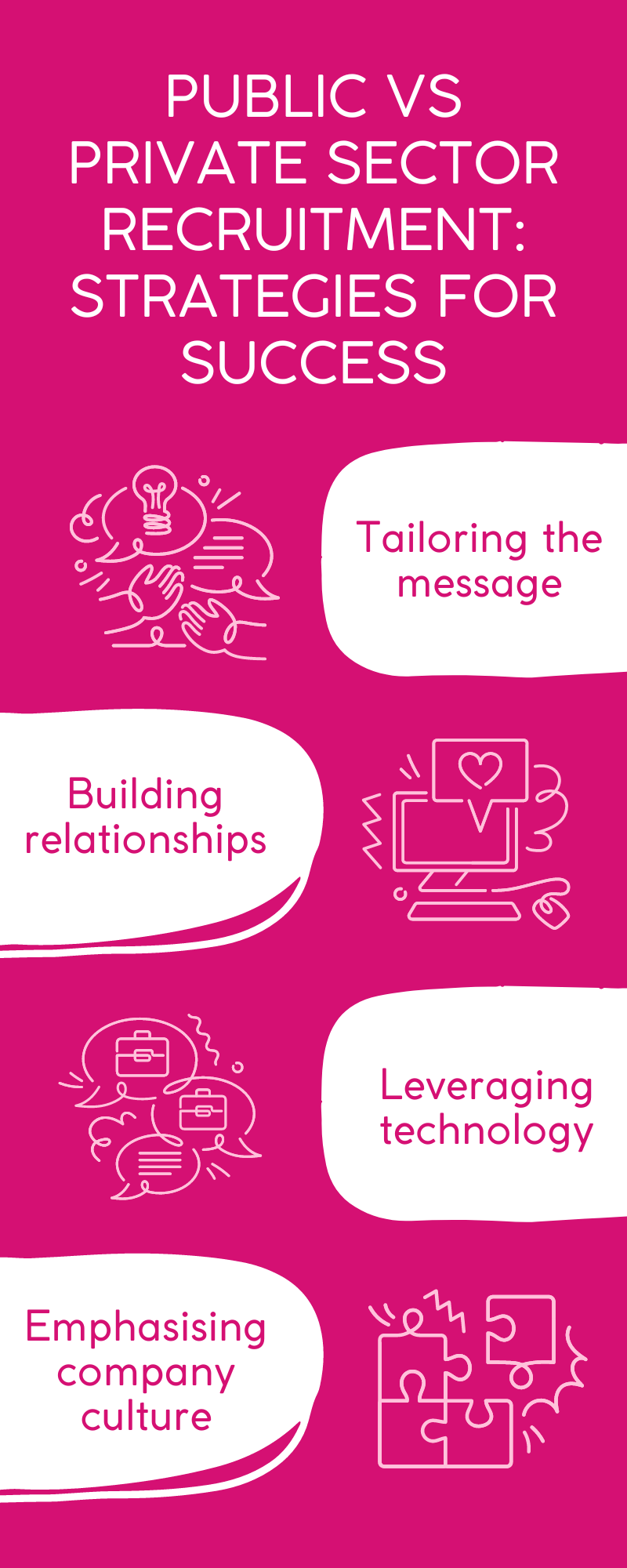Public vs Private Sector Recruitment: Key Differences
Public vs Private Sector Recruitment: Key Differences

Recruiting the right talent is a fundamental aspect of any organisation's success, whether it operates in the public or private sector. However, the recruitment landscapes in these two sectors differ significantly, each presenting unique challenges and opportunities.
In this comprehensive guide, we will explore the critical differences between public and private sector recruitment, shedding light on their respective requirements, processes, and expectations.
By understanding these distinctions, businesses and recruitment professionals can effectively navigate these environments to secure top-tier talent. Additionally, we will showcase how our tailored recruitment services cater to the needs of both sectors, ensuring successful talent acquisition and retention.
Overview of Public and Private Sector Recruitment
Before delving into the nuances, let's first establish a clear understanding of public and private sector recruitment. The public sector encompasses governmental organisations, such as local, state, and federal agencies, as well as non-profit institutions. On the other hand, the private sector includes commercial businesses, ranging from small enterprises to multinational corporations. Despite their differences, both sectors share a common goal: to attract the best candidates who align with their values and objectives.
Key Differences and Similarities
- Organisational Structure: One of the primary distinctions between the two sectors lies in their organisational structure. Public sector entities often follow hierarchical structures with defined levels of authority and decision-making processes. Private sector organisations, on the other hand, can be more flexible and agile, allowing for quicker responses to market changes.
- Funding and Budget Constraints: Public sector organisations typically rely on government funding or donations, which can result in budget constraints affecting their recruitment efforts. Private sector companies, driven by profits, may have more substantial resources dedicated to talent acquisition.
- Purpose and Mission: Public sector organisations are mission-driven, focusing on providing services and benefits to the community. In contrast, private sector entities are profit-driven, concentrating on achieving financial success.
- Long-Term Stability vs. Growth Potential: Public sector jobs often offer long-term stability and benefits, attracting candidates seeking security. Private sector roles may present more significant growth opportunities, especially in rapidly expanding industries.
Recruitment Processes and Expectations in the Public Sector

Recruiting for the public sector involves adherence to specific regulations and guidelines to ensure fairness, compliance, and transparency in the hiring process.
Compliance, Transparency, and Diversity
- Equal Employment Opportunities: Public sector organisations are committed to providing equal employment opportunities to all candidates, regardless of their background. This commitment extends to avoiding any form of discrimination during the recruitment process.
- Transparency and Accountability: The public sector is accountable to the public it serves. As such, the recruitment process must be transparent and well-documented, providing visibility into the decision-making process.
- Diversity and Inclusion: Encouraging diversity and inclusion is a significant focus in the public sector. Recruitment efforts often target underrepresented groups to create a workforce that reflects the community's diversity.
Challenges in Public Sector Recruitment
- Bureaucracy and Lengthy Processes: The bureaucratic nature of public sector organisations can slow down the recruitment process, making it more time-consuming compared to private sector recruitment.
- Salary and Compensation Constraints: Public sector salary structures may be less competitive than their private sector counterparts, making it challenging to attract certain high-demand skill sets.
- Limited Flexibility: Strict regulations and policies can limit the flexibility of public sector recruiters to tailor job offers to individual candidates.
Navigating Private Sector Recruitment
Private sector recruitment is often characterised by its speed, competitiveness, and the need for specific skill sets.
Speed, Competition, and Skill Requirements
- Agility and Speed: In the private sector, time is of the essence. Competition for top talent can be fierce, prompting companies to streamline their recruitment processes to secure the best candidates before their competitors.
- Market-Based Salaries and Incentives: Private sector organisations adjust their salary offers based on market demand, making it possible to attract high-demand professionals with competitive compensation packages.
- Industry-Specific Skills: Depending on the industry, private sector recruiters often seek candidates with specialised skills and expertise to gain a competitive edge.
Challenges in Private Sector Recruitment
- High Turnover: Private sector employees may switch jobs frequently, leading to higher turnover rates compared to the public sector.
- Candidate Screening Overload: The volume of applications in the private sector can be overwhelming, making candidate screening and selection a challenging task.
Strategies for Success: Adapting Your Recruitment Approach to Suit Sector-Specific Needs

To succeed in both public and private sector recruitment, organisations and recruiters must tailor their strategies accordingly.
Tailoring the Message
When recruiting for the public sector, focus on the organisation's mission and its impact on the community. Highlight the value of job security and opportunities for career advancement. The private sector, emphasises growth opportunities, a dynamic work environment, and attractive compensation packages.
Building Relationships
In both sectors, relationship-building is crucial. In the public sector, forming strong connections with community leaders and advocacy groups can aid in attracting diverse talent. In the private sector, establishing relationships with professional networks and industry associations can provide access to top candidates.
Leveraging Technology
Both sectors can benefit from leveraging technology to streamline recruitment processes, enhance the candidate experience, and identify suitable candidates more efficiently.
Emphasising Company Culture
For private sector organisations, showcasing a vibrant company culture that aligns with candidates' values can be a compelling recruitment tool. In the public sector, emphasising the organisation's positive impact on society and the opportunity to contribute to the greater good can attract mission-driven candidates.
Macildowie's Expertise: How Our Tailored Recruitment Solutions Support Both Public and Private Sector Clients

At Macildowie, we understand the distinct needs of both public and private sector clients. Our expertise enables us to provide tailored recruitment solutions that align with the unique characteristics of each sector.
Understanding Sector-Specific Challenges
We comprehend the compliance, transparency, and diversity requirements in the public sector, ensuring our recruitment processes adhere to the highest standards of fairness and accountability. For private sector clients, we offer agile, speedy recruitment services that identify candidates with the specialised skills necessary for success in their industries.
Personalised Approach
We recognise that one size does not fit all. Our personalised approach considers the individual needs and preferences of each client, ensuring we attract and retain top talent effectively.
Extensive Network
Our vast network of connections in both the public and private sectors enables us to access a wide pool of qualified candidates, enhancing the chances of finding the perfect match for every role.
In conclusion, public and private sector recruitment each presents their distinct challenges and opportunities. While the public sector focuses on compliance, transparency, and diversity, the private sector emphasises speed, competition, and specialised skills. Successfully navigating these recruitment landscapes requires tailored strategies and a deep understanding of sector-specific needs.
Conclusion
Whether you're in the realm of private sector businesses or navigating the intricacies of government agencies and civil service, understanding the nuances of recruitment is crucial. Private sector jobs often come with the allure of rapid growth and competitive benefits packages, while public sector employees are drawn to the stability and the chance to provide services to the public. On the flip side, private sector employers face challenges like high turnover and a saturated market of candidates, whereas those in the public sector, including emergency services and federal, state, or local government, grapple with bureaucracy and long-term budget constraints.
Adapting your recruitment strategies to these distinct landscapes is key to attracting top talent. Whether you're working in the private sector or offering roles in the public sector, leveraging technology and building strong networks can make a significant difference. From benefits packages in the private sector to long-term job security in the public sector, knowing what appeals to your target candidates will set you apart from the competition. So, whether you're hiring for private and public roles, remember that each sector has its unique challenges and opportunities, and a tailored approach is essential.
FAQs
Public sector recruitment is often more bureaucratic and adheres to strict regulations, focusing on compliance, transparency, and diversity. Private sector recruitment, on the other hand, is characterised by speed, competition, and the need for specific skill sets.
Some of the challenges in public sector recruitment include lengthy processes due to bureaucracy, salary and compensation constraints, and limited flexibility in tailoring job offers.
Challenges in private sector recruitment include high turnover rates, handling an overwhelming volume of applications, and the need to constantly compete for top talent.
Organisations should tailor their message to emphasise different aspects of the job depending on the sector, build strong relationships with relevant networks, leverage technology for streamlined processes, and showcase their company culture to attract the right candidates.
We provide tailored recruitment solutions that understand and address the specific challenges of each sector. We have an extensive network of connections in both sectors and offer a personalised approach to attracting and retaining top talent effectively.
